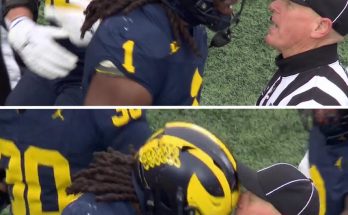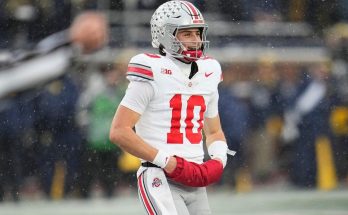The college football landscape is constantly shifting, and this week, it took another dramatic turn as two powerhouse programs — Texas and Penn State — both dropped out of the latest AP Top 25 Poll. For programs steeped in tradition, resources, and expectations, this fall from the national rankings is not merely about numbers on a list — it’s a reflection of deeper problems that extend from performance on the field to perception off it. The fact that neither Texas nor Penn State has recorded a single Power Four win this season speaks volumes about where each program stands, and raises difficult questions about identity, leadership, and direction.
For Texas, the fall feels particularly sharp. Just months ago, the Longhorns were being talked about as legitimate national title contenders. Coming off an impressive 2024 season and entering their first year fully entrenched in the SEC, the expectations were sky-high. Steve Sarkisian had been credited with restoring order and confidence in Austin, recruiting classes were ranked among the nation’s best, and the quarterback room — led by Quinn Ewers and backed by Arch Manning — looked as deep and dynamic as any in the country. Yet, as October arrives, the Longhorns find themselves staring at a sobering reality: hype does not equal execution.
Their losses have been telling. Against top competition, Texas has looked unconvincing — struggling to find offensive rhythm, making costly mistakes in crunch time, and failing to impose their physicality against stronger Power Four opponents. The Longhorns’ trademark swagger seems muted, replaced by hesitation and inconsistency. For a team that prides itself on its “We’re back” mantra, it’s becoming increasingly hard to argue that this iteration of Texas football has truly arrived. The problem isn’t just the scoreboard; it’s the inability to deliver when the lights are brightest.
Meanwhile, in Happy Valley, Penn State’s situation feels eerily familiar. For years, the Nittany Lions have existed in a frustrating middle ground — good enough to be relevant, but never quite good enough to break into the elite circle consistently occupied by Ohio State, Michigan, and Georgia. Under James Franklin, Penn State has recruited well, developed pros, and maintained a competitive standard. Yet, the failure to secure a Power Four win this season reveals an alarming stagnation. Despite all the talent, all the preparation, and all the resources at their disposal, Penn State looks like a team spinning its wheels — talented but toothless, competitive but not clutch.
The loss column tells only part of the story. What’s more concerning is how Penn State has lost — in predictable fashion, with familiar flaws resurfacing time and again. The offense lacks explosion, the passing game remains inconsistent, and the offensive line continues to be overmatched against top-tier defenses. Drew Allar, once billed as the next great Big Ten quarterback, has struggled to find his rhythm, and the play-calling has been conservative to the point of self-sabotage. Defensively, Manny Diaz’s unit has done its best to keep the team afloat, but when the offense can’t sustain drives or convert critical third downs, even the best defenses eventually bend — and then break.
Dropping out of the AP Poll is symbolic, but it’s not just about optics. For both Texas and Penn State, it represents a crisis of identity. These are not programs used to being on the outside looking in. They measure success by championships and rankings, not rebuilding excuses. Yet, both now find themselves forced to confront uncomfortable truths: that in the modern college football arms race, tradition and recruiting stars alone no longer guarantee success. The Power Four era has compressed the margins between the good, the great, and the forgotten, and both the Longhorns and Nittany Lions are learning that hard lesson in real time.
For Texas, the move to the SEC was supposed to be a statement — a declaration that the Longhorns were ready to compete at the sport’s highest level. Instead, it’s revealed how far they still have to go. The speed, size, and physicality of SEC football have exposed cracks in their foundation. The offensive line, despite its blue-chip pedigree, has struggled against elite pass rushes. The defense, while improved, hasn’t been able to create game-changing turnovers. Even special teams, long a point of pride, have faltered at key moments. It’s not that Texas lacks talent — they have plenty. What they lack is cohesion and maturity, the kind that separates playoff teams from pretenders.
Penn State’s challenge, on the other hand, feels more psychological. The Nittany Lions have all the makings of a top-10 program — elite facilities, strong fan support, and a deep roster. But when faced with elite opposition, they seem to shrink. It’s not about talent; it’s about belief. James Franklin’s tenure has brought stability, but the inability to win signature games has become an albatross around the program’s neck. Every season seems to follow the same script: a fast start, a midseason stumble, and a finish that leaves fans wondering what could have been. The failure to notch a single Power Four victory this season isn’t just a statistic — it’s a symptom of a program that’s lost its edge.
In the broader context of college football, this development has ripple effects. Rankings matter not just for bragging rights, but for recruiting, media coverage, and program momentum. When teams like Texas and Penn State drop out, it opens the door for emerging programs — schools like Ole Miss, Oregon State, or Kansas — to claim the spotlight. The new Power Four landscape rewards teams that adapt quickly, innovate schematically, and play fearlessly. Programs resting on reputation alone will find themselves left behind. And for Texas and Penn State, that’s an existential threat.



